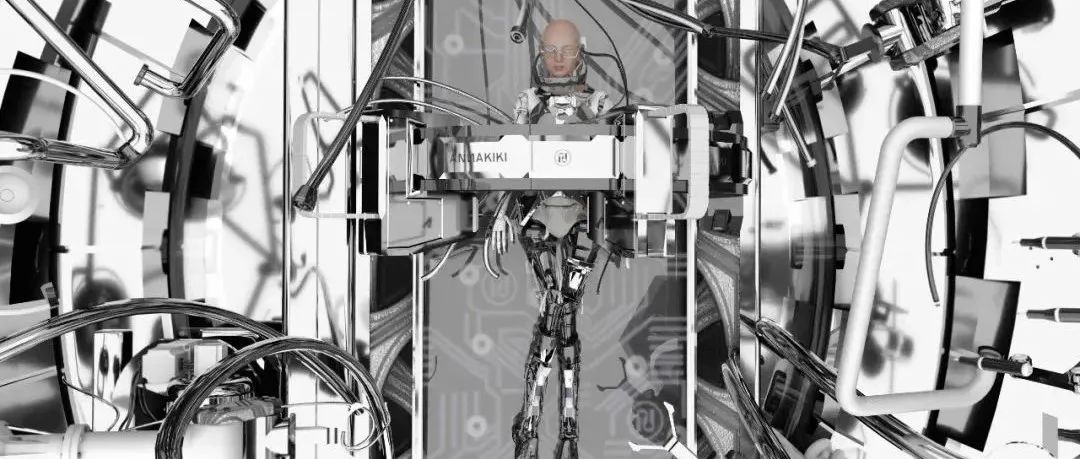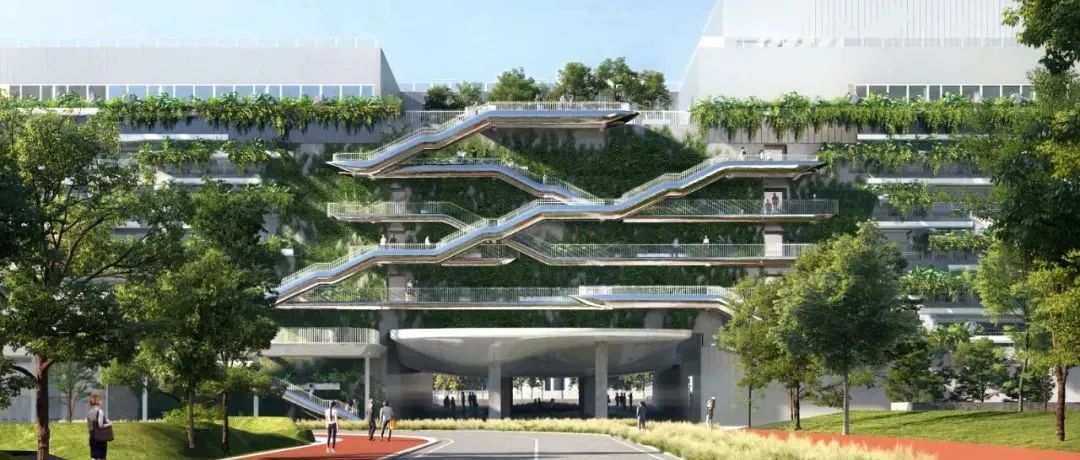斯坦福大学医学院学术医学中心获得由美国国家结构工程师协会委员会(NCSEA: National Council of Structural Engineers Associations) 颁发的2021年度卓越结构工程奖杰出项目奖。
这是HOK连续四年获得NCSEA卓越结构工程奖。此前的获奖项目包括纽约拉瓜迪亚机场B航站楼的人行天桥(2020年)、美国亚特兰大哈兹菲尔德-杰克逊国际机场升级改造(2019年)和梅赛德斯-奔驰体育场高清环形显示屏(2018年)。奖项是以创新设计、工程成就和创造力为评判依据。
图1:美国纽约拉瓜迪亚机场B航站楼的人行天桥(2020年)| Image 1: Pedestrian Bridge at LaGuardia Airport’s Terminal B (2020)
图2:美国亚特兰大哈兹菲尔德-杰克逊国际机场升级改造(2019年)| Image 2: Hartsfield-Jackson Atlanta International Airport Modernization (2019)
图3:美国梅赛德斯-奔驰体育场高清环形显示屏(2018年)| Image 3: Mercedes-Benz Stadium Halo Board (2018)
项目地点:美国 加州 帕洛阿托
项目规模:19,500平方米
服务:建筑设计、景观设计、顾问咨询、工程、环境健康设计、室内设计、规划 + 城市设计、可持续发展设计
HOK为斯坦福大学医学院打造了一个能够进行学术和研究工作的学术医学中心,同时为医院和诊所长时间工作的员工打造了一个休憩空间。设施包括办公室、会议室、协作和教育空间、健身中心和餐厅式咖啡馆。
设计团队帮助医学院的领导规划了新的办公空间,并制定了一个能够为所有教职员工提供高度协作的工作环境的详细计划。
学术医学中心位于斯坦福医学院学术和临床校区与相邻的弗雷德里克·劳·奥尔姆斯特德设计的植物园之间。
三个窄长、相连的办公楼翼楼矗立在一个种植着本土物种的庭院之上。西办公楼的翼楼被抬高,下面是一个两层高的大门廊。在这座U形建筑里,人们可以从各角度欣赏窗外景观。
庭院:通往自然的门户
这座建筑是围绕着一个种植了本土物种的庭园而设计的。人们可以通过采石场路进入庭院,并通过连接的小径直接通往植物园。可以俯瞰庭院的走道提供可以从室外直接进入翼楼的通道。连桥横越庭院的边缘。
归属感
建筑通过建立多个从中央庭院进入公共区域的入口,给人们一种开放并热情友好的感觉。办公区不能随便出入,以确保办公空间的安全性。
大型入口广场和庭院在一楼提供公共空间。这些设施包括:餐厅式咖啡馆、会议室和健身中心。通过新的通道可以到达公共艺术和景观空间。
户外办公空间
团队利用了加利福尼亚州北部的温和气候,将20%的功能移到了建筑外。为人们提供各种各样的户外空间,以进行社交和工作。
门廊、阳台、天桥和走道从大楼延伸出来。上层露天平台营造出置身于树林中的感觉。人们可以在这些空间享受夏季的微风和阴凉,冬季的宁静和阳光。
可持续设计
设计将建筑对环境的影响降至最低。窄长的办公楼翼楼和混合结构柱网减少了建筑的占地面积和建筑材料。
被动式设计为优先的设计策略充分利用了场地条件。太阳、风和生态系统影响了从规划决策到建筑细节。狭窄的建筑翼楼加上落地窗,为人们提供了充足的自然光和能够欣赏到植物园景观的视野。
三层楼高的金属百叶窗板幕墙和西立面的陶瓷熔块图案最大限度地减少了眩光,同时优化了室内热舒适度和日光照射。该建筑的年能源使用强度为15.9 kBtu/sf/yr(包括可再生能源),比基准值节省了85%的能源。
亲生物设计
设计团队创建了亲生物设计指南。
加州栎启发了建筑的设计,与加州本土树木一样,能够在一个空间内容纳多个环境。它的叶子阻挡阳光直射,同时允许过滤后的光线和微风透过,在树冠下创造了一个凉爽空气的微生境。其结构强化了分层效果,创造了空间感和运动感。
内部功能
翼楼的狭窄型设计是为确保所有的工作空间距离窗户不超过30英尺(近9米)。这使所有空间使用者都能享受到自然光以及附近植物园和医学院的景色。
入口大厅和大型内部聚集空间位于西南角,在那里人们可以享受充分的自然光。
学术医学中心作为一个聚集的社区,主要协作区位于两翼的角落和末端。与室外露台相邻的“能量站”可作为工作区或休息区给人们提供更多的空间选择。
社区连通性
学术医学中心可通过大学免费的电动公交系统以及穿过植物园的自行车道和步行道进入。场地包含停车场,以供停放自行车。
地下车库替代了地面停车场,这种停车场在加利福尼亚州的许多写字楼开发项目中很普遍。该中心位于斯坦福购物中心附近,街道对面有几家餐厅,交通非常便利。
Stanford Center for Academic Medicine Honored for Excellence in Structural Engineering
The Stanford School of Medicine Center for Academic Medicine was an Outstanding Project Winner in the 2021 Excellence in Structural Engineering Awards presented by the National Council of Structural Engineers Associations (NCSEA).
This is the fourth straight year HOK has won an NCSEA Excellence in Structural Engineering Award. Previous winners have included the Pedestrian Bridge at LaGuardia Airport’s Terminal B (2020), the Hartsfield-Jackson Atlanta International Airport Modernization (2019) and the Mercedes-Benz Stadium Halo Board (2018). Projects are judged on innovative design, engineering achievement and creativity.
Location: Palo Alto, California
Size: 210,000 sq. ft. / 19,500 sq. m.
Services: Architecture, Consulting, Engineering, Health + Well-Being, Interiors, Landscape, Architecture, Planning + Urban Design, Sustainable Design
HOK designed the Stanford Center for Academic Medicine to provide respite for staff that work long hours in hospitals and clinics. It also accommodates their academic and research endeavors. The facility includes offices, conference rooms, collaboration and education spaces, a fitness center and restaurant-style café.
HOK’s team helped the medical school’s leaders plan their new office space and develop a detailed program that would accommodate all clinical faculty and staff in a highly collaborative work environment.
The building massing serves as a threshold between the Stanford Medicine academic and clinical campus in Palo Alto and the adjacent Frederick Law Olmsted-designed arboretum.
Three narrow, interconnected office wings rise above a landscaped courtyard planted with native species. The west office wing is lifted above the ground, forming a large, two-story porch below. The U-shaped building provides views to nature from all vantage points.
Courtyard: Portal to Nature
The building is designed around a landscaped courtyard planted with native species. Publicly accessible through an open-air breezeway along Quarry Road, it connects to the arboretum’s trails.
Walkways overlooking the courtyard provide outdoor access from office wings. Bridges traverse the courtyard edges.
A Sense of Community
The building feels open and welcoming, with many public areas easily accessible from the central courtyard. Access to office areas is controlled and secure.
The large entry plaza and courtyard are designed for communal uses on the ground floor: a restaurant-style café, conference room and fitness center.
New pathways at the ground plane connect to public art and landscape features.
Outdoor Workspaces
The design takes advantage of Northern California’s mild climate by moving 20 percent of the program beyond the building’s walls. People can socialize and work in a diverse mix of outdoor spaces.
Porches, balconies, sky bridges and covered walkways extend from the building. Upper terraces create the sensation of being in the trees. These spaces experience breezes and shade in the summer and calmness and direct sunlight in the winter.
Sustainable Design
The design minimizes the Center’s impact on the environment. The slender wings and mixed structural column grid reduce the building’s footprint and materials.
A passive-first design approach takes full advantage of the site. The sun, wind and ecosystem influenced everything from the initial planning decisions to the building details. Narrow building wings coupled with floor-to-ceiling windows allow plenty of natural light and views to the arboretum.
The curtain wall—with ceramic frit patterns and three-story metal louvres on the west facade—minimizes glare while optimizing indoor thermal comfort and daylight. The building’s annual energy use intensity—15.9 kBtu/sf/yr (including renewables)—represents an 85% energy savings from baseline.
Genius of Biome
The team created biophilic design guidelines.
The coast live oak tree inspired the design of the Center, which, like the native Californian tree, houses multiple environments within a single space. Its foliage blocks direct sun while allowing filtered light and breezes to pass through, creating a microhabitat of cool air under its canopy. Its structure reinforces the layering effect, creating a sense of space and movement.
Internal Organization
The building wings are intentionally narrow, with no workspaces more than 30 feet from a window. This gives all occupants access to natural light and views of the neighboring arboretum and School of Medicine.
The entrance lobby and large interior gathering spaces are in the southwest corner, illuminated by natural light.
Organized as a collection of neighborhoods, the Center’s primary collaboration zones occur at the corners and ends of the wings. ‘Refuel stations’ adjacent to outdoor terraces provide alternative workspaces and areas for respite.
Community Connectivity
The Center is accessible via the university’s free, electrified public transportation system, as well as the bike paths and walking trails that run through the arboretum. On-site bike parking is available.
An underground garage eliminates the need for the surface parking that is prevalent in many California office developments.
The Center is conveniently located near the Stanford Shopping Center and several restaurants across the street.
本文来自微信公众号“HOK贺克”(ID:hok_ap)。大作社经授权转载,该文观点仅代表作者本人,大作社平台仅提供信息存储空间服务。












